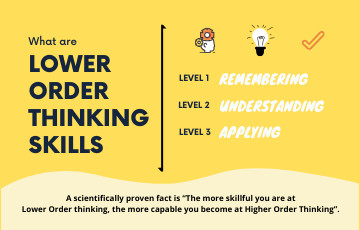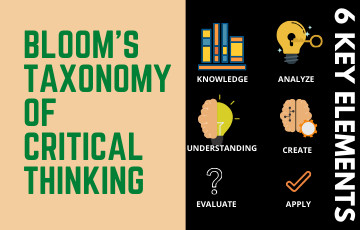
Gain insights into lower-order thinking skills and their significance in learning and problem-solving processes. Expand your understanding.
Lower-order thinking skills (LOTS) form the building blocks necessary for advancing to higher-order thinking skills (HOTS).
Lower-order thinking skills encompass fundamental abilities individuals acquire during their developmental stages, including:
Observation
Memorization
Recollection
Comprehension
These skills are cultivated throughout the foundational stages of education.
A scientifically proven fact is “The more skillful you are at Lower Order thinking, the more capable you become at Higher Order Thinking”.
3 Levels of Lower-Order Thinking Skills
According to Bloom’s taxonomy of critical thinking, there are three levels within the Lower Order Thinking Skills category:
Recollection
Comprehension
Application
Level 1: Remembering - Assessing Your Ability to Recall Information
At this initial level, one's proficiency in:
Defining
Recalling
Recognizing
Comprehending
Identifying
And adopting selective approaches, are fundamental skills within the domain.
Moreover, it involves:
The capacity to identify problems.
Recalling past experiences to detect patterns or similarities.
Level 2: Understanding - Gauging Your Capacity to Explain Previous Perceptions
The understanding phase hinges on your capability to:
Explain
Describe
Paraphrase
Infer
Summarize
Classify
Compare data gathered from the preceding level.
Understanding is pivotal within Lower Order Thinking as it encapsulates a succinct grasp of the underlying problem.
Level 3: Applying – Implementing Inferences Drawn from Levels 1 and 2
This stage revolves around:
Solving
Operating
Executing
Choosing
Demonstrating ideas gleaned from earlier levels.
It entails devising concrete strategies to progress towards higher levels of critical thinking.
Key Insight:
Just as climbing a mountain begins at its foothills, developing strong critical thinking skills entails honing Lower Order Thinking Skills before advancing to Higher Order Thinking Skills (HOTS).

Benjamin Bloom formulated a pyramid made of six key elements of critical thinking. The framework suggests that to excel in critical thinking, one has to go through the levels mentioned in the pyramid.
The six key elements of bloom’s critical thinking framework (revised) are:
- Knowledge/Remembering
- Understanding
- Applying
- Analyzing
- Evaluating
- Creating
Level 1: Knowledge/Remembering
An individual’s ability to:
· Grasp basic concepts
· Recall facts
· Define problems
· Remember from memory
· Ability to repeat or recollect information
Level 2: Understanding
An individual’s ability to identify, describe and define a problem. Also, this level is where an individual classifies and explains problem-associated factors. And recognize the key reasons behind problems.
Level 3: Applying
The ability to execute tasks or implement solutions the right way!
This level is where critical thinkers resolve, interpret, and schedule tasks and solutions.
Level 4: Analyze
This level is where an individual:
- Draws correlations
- Ask questions
- Does examinations
- Experiments multiple ideas
- makes comparisons
- Review previous groundworks
The actual Problem scenario gets shaped at this level.
Level 5: Evaluate
You have analyzed all the variables and have come to the last stand. On this fifth level, defend and justify your eventual decision/stand.
You should argue, defend, add value, add support, and explain why this last solution is right for the problem.
Level 6: Create
You resolve the problem by applying the final-solution. This level is where you implement your original ideas and works into assembly after justifying it.
How Bloom’s Taxonomy is related to Critical Thinking?
Bloom further divided the six key elements of critical thinking into two major categories called:
- Lower Order Thinking Skills: Knowledge, Remembering, Understanding, Applying
- Higher-Order Thinking Skills: Analyze, Evaluate, Create
Bloom suggests that to become a good critical thinker, one has to develop both Higher-Order and Lower Order thinking skills.


